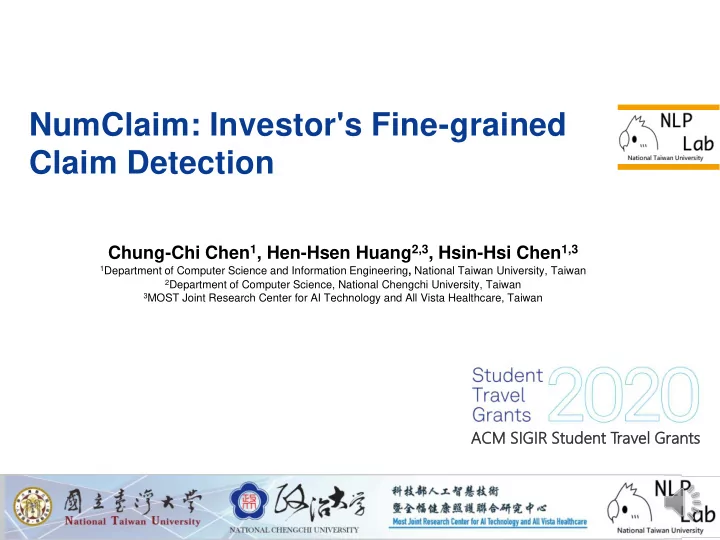

NumClaim: Investor's Fine-grained Claim Detection Chung-Chi Chen 1 , Hen-Hsen Huang 2,3 , Hsin-Hsi Chen 1,3 1 Department of Computer Science and Information Engineering , National Taiwan University, Taiwan 2 Department of Computer Science, National Chengchi University, Taiwan 3 MOST Joint Research Center for AI Technology and All Vista Healthcare, Taiwan ACM SIGIR R Stud uden ent t Travel el Grants ts
Overview • Argument mining issue in finance • Expert-annotated dataset, NumClaim • We show that encoding with numeral encoder and co- training with the numeral understanding auxiliary task are helpful for the numeral-oriented task. 2
Motivation • Over 58.47% of sentences in analysis report contain at least one numeral • Investors always make a claim with an estimation • (X) We estimate that the sales may growth • (O) We estimate that the sales growth rate may exceed 40% • The importance of fine-grained claims and the numerals. • We estimate that the sales growth rate may exceed 5% • We estimate that the sales growth rate may exceed 40% 3
NumClaim • Chinese financial analysis reports • The annotators work in the financial industry (bank’s treasury department and hedge fund) • The Cohen’s kappa agreements between the experts are 88.31% • 5,144 instances: 23.78% “In - claim” and 76.22% “Out -of- claim” 4
Auxiliary Task – Numeral Understanding • The Cohen’s kappa agreements between the experts are 89.55% 5 Chung-Chi Chen, Hen-Hsen Huang, Yow-Ting Shiue, and Hsin-Hsi Chen. 2018. Numeral understanding in financial tweets for fine-grained crowd-based forecasting. In IEEE/WIC/ACM International Conference on Web Intelligence
Statistics [12] Steffen Eger, Johannes Daxenberger, and Iryna Gurevych. 2017. Neural End-to-End Learning for Computational Argumentation Mining. In ACL [13] Steffen Eger, Johannes Daxenberger, Christian Stab, and Iryna Gurevych. 2018.Cross-lingual Argumentation Mining: 6 Machine Translation (and a bit of Projection) is All You Need!. In COLING.
Experimental Results • Encoding: BERT • Baseline: CNN, BiGRU, CapsNet • Metrics: Macro-F1 • Class Weight (CW) • Numeral Encoder • Represent the digit (0-9) and the decimal point as a 11- dimension tensor, and concatenate it with a tensor for the inter-numeral position information. • Joint Learning with Category Classification Task (CG) 7
Conclusion & Future Direction • Our contributions • Explore the argument mining issue in finance • Provide an expert-annotated dataset – NumClaim • Propose helpful methods for solving numeral-oriented task • Future Directions – Fine-grained Financial Opinion Mining • Premise detection and relation linking • Rationality assessment Chung-Chi Chen, Hen-Hsen Huang, and Hsin-Hsi Chen. 2020. Fine-grained Financial Opinion Mining: A 8 Survey and Research Agenda. In arXiv:2005.01897
Related Datasets and Events • FinNum-1: Fine-Grained Numeral Understanding in Financial Tweets (NTCIR-14, 2018-2019) • FinNum-2: Numeral Attachment in Financial Tweets (NTCIR-15, 2019- 2020) • FinNum-3: Investor's Fine-grained Argument Detection (Will submit proposal to NTCIR-16) • Tutorial in AACL-IJCNLP 2020: Natural Language Processing in Financial Technology Applications • Springer SpringerBriefs: Financial Opinion Mining (Available in 2021) Chung-Chi Chen, Hen-Hsen Huang, and Hsin-Hsi Chen. 2020. NLP in FinTech Applications: Past, Present 9 and Future . In arXiv:2005.01320.
Feel free to contact us if you have any questions. Chung-Chi Chen: cjchen@nlg.csie.ntu.edu.tw ACM SIGIR R Stude dent t Travel vel Grants nts
Recommend
More recommend